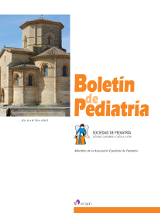Insulino-resistencia, acantosis nigricans y obesidad en la adolescencia
S. Cuartas, M.É. Pérez Torre
Bol. Pediatr. 2015; 55 (234): 262 - 265
Introducción. Se denomina acantosis nigricans a la lesión cutánea en la que se observa hiperpigmentación en zonas de roce (axila, nuca, ingle o región poplítea) La importancia clínica es la asociación con hiperinsulinismo e insulinorresistencia. Los objetivos fueron analizar los factores que determinan la presencia de resistencia a la insulina en un paciente adolescente con obesidad y el objetivo secundario es revisar la bibliografía que relaciona esta alteración metabólica con la acantosis nigricans, para relacionarlo con futuros riesgos. Caso clínico. Se presenta un adolescente de 14 años, hijo de padre con diabetes tipo 2, sobrepeso severo, insulinorresistencia y acantosis nigricans. Que presenta aumento del perímetro de cintura e hiperinsulinismo, hipertrigliceridemia, descenso del colesterol HDL, con glucemia y curva de tolerancia a la glucosa normales. Índice HOMA de 6,89 y ratio TG/HDLc elevado de 4,52. Ecografía abdominal sin esteatosis hepática y tensión arterial normal. En función de la revisión bibliográfica realizada, se describe que el paciente presenta un riesgo elevado de padecer diabetes tipo 2 y enfermedad cardiovacular en el futuro. Conclusiones. La presencia de acantosis nigricans en niños y adolescentes puede ayudar a identificar alteraciones clínicas y etabólicas,fundamentalmente si se asocia con obesidad.
Insulin-resistance, acanthosis nigricans and obesity in adolescents
Introduction. Acanthosis nigricans is a skin lesion in which hyperpigmentation in areas of friction (armpit, neck, groin or popliteal region) The clinical importance is the association with hyperinsulinemia and insulin resistance. The aims are this clinical report was to analyze the factors that determine the insulin resistance in this patient with obesity. And the secondary objective was to review the literature relating this metabolic disorder with acanthosis nigricans, to relate to future risks. Case report. We analyze the case a 14 year old boy who has a father with diabetes mellitus type 2, severely overweight, insulin resistance and acanthosis nigricans is presented. He present increased waist circumference and hyperinsulinemia, hypertriglyceridemia, decreased HDL colesterol, normal glycemia and without disorder curve glucose tolerance. HOMA: 6.89, TG/HDL high of 4.52. Abdominal ultrasound without hepatic steatosis and normal blood pressure. Based on the literature review disclosed that the patient present a high risk of diabetes mellitus type 2 and cardiovacular disease in the future. Conclusions. The presence of acanthosis nigricans in children and adolescents can help identify clinical and metabolic alterations, mainly if associated with obesity.
Artículo completo (PDF) (309 kb.)
- Endocrino-Metabolismo
